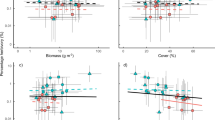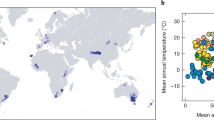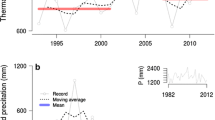Abstract
Plant diversity is a key driver of ecosystem functioning best documented for its influence on plant productivity. The strength and direction of plant diversity effects on species interactions across trophic levels are less clear. For example, with respect to the interactions between herbivorous invertebrates and plants, a number of competing hypotheses have been proposed that predict either increasing or decreasing community herbivory with increasing plant species richness. We investigated foliar herbivory rates and consumed leaf biomass along an experimental grassland plant diversity gradient in year eight after establishment. The gradient ranged from one to 60 plant species and manipulated also functional group richness (from one to four functional groups—legumes, grasses, small herbs, and tall herbs) and plant community composition. Measurements in monocultures of each plant species showed that functional groups differed in the quantity and quality of herbivory damage they experienced, with legumes being more damaged than grasses or non-legume herbs. In mixed plant communities, herbivory increased with plant diversity and the presence of two key plant functional groups in mixtures had a positive (legumes) and a negative (grasses) effect on levels of herbivory. Further, plant community biomass had a strong positive impact on consumed leaf biomass, but little effect on herbivory rates. Our results contribute detailed data from a well-established biodiversity experiment to a growing body of evidence suggesting that an increase of herbivory with increasing plant diversity is the rule rather than an exception. Considering documented effects of herbivory on other ecosystem functions and the increase of herbivory with plant diversity, levels of herbivory damage might not only be a result, but also a trigger within the diversity–productivity relationship.


Similar content being viewed by others
References
Andow DA (1991) Vegetational diversity and arthropod population response. Annu Rev Entomol 36:561–586
Barth RH, Wardle DA (1982) The invertebrate world. Saunders College, Philadelphia
Belovsky GE, Slade JB (2000) Insect herbivory accelerates nutrient cycling and increases plant production. Proc Natl Acad Sci USA 97:14412–14417
Bernays EA, Bright KL (1993) Mechanisms of dietary mixing in grasshoppers—a review. Comp Biochem Physiol A-Physiol 104:125–131
Bernays EA, Bright KL, Gonzalez N, Angel J (1994) Dietary mixing in a generalist herbivore—tests of 2 hypotheses. Ecology 75:1997–2006
Borer ET, Seabloom EW, Tilman D (2012) Plant diversity controls arthropod biomass and temporal stability. Ecol Lett 15:1457–1464
Brown DG (1994) Beetle folivory increases resource availability and alters plant invasion in monocultures of goldenrod. Ecology 75:1673–1683
Chapin FS III et al (1997) Biotic control over the functioning of ecosystems. Science 277:500–504
Coll M, Bottrell DG (1994) Effects of nonhost plants on an insect herbivore in diverse habitats. Ecology 75:723–731
Coupe MD, Cahill JF (2003) Effects of insects on primary production in temperate herbaceous communities: a meta-analysis. Ecol Entomol 28:511–521
Duffy JE, Cardinale BJ, France KE, McIntyre PB, Thebault E, Loreau M (2007) The functional role of biodiversity in ecosystems: incorporating trophic complexity. Ecol Lett 10:522–538
Ebeling A, Klein AM, Schumacher J, Weisser WW, Tscharntke T (2008) How does plant richness affect pollinator richness and temporal stability of flower visits? Oikos 117:1808–1815
Ebeling A, Klein AM, Weisser WW, Tscharntke T (2012) Multitrophic effects of experimental changes in plant diversity on cavity-nesting bees, wasps, and their parasitoids. Oecologia 169:453–465. doi:10.1007/s00442-00011-02205-00448
Fahnestock JT, Knapp AK (1993) Water relations and growth of tallgrass prairie forbs in response to selective grass herbivory by bison. Int J Plant Sci 154:432–440
Greenwood P, Halstead A (2009) Schädlinge & Krankheiten. Dorling Kindersley, London
Haddad NM, Tilman D, Haarstad J, Ritchie M, Knops JMH (2001) Contrasting effects of plant richness and composition on insect communities: a field experiment. Am Nat 158:17–35
Haddad NM, Crutsinger GM, Gross K, Haarstad J, Knops JMH, Tilman D (2009) Plant species loss decreases arthropod diversity and shifts trophic structure. Ecol Lett 12:1029–1039
Hector A et al (1999) Plant diversity and productivity experiments in European grasslands. Science 286:1123–1127
Heisse K, Roscher C, Schumacher J, Schulze ED (2007) Establishment of grassland species in monocultures: different strategies lead to success. Oecologia 152:435–447
Hooper DU, Vitousek PM (1997) The effects of plant composition and diversity on ecosystem processes. Science 277:1302–1305
Hulme PE (1996) Herbivory, plant regeneration, and species coexistence. J Ecol 84:609–615
Hunt-Joshi TR, Blossey B, Root RB (2004) Root and leaf herbivory on Lythrum salicaria: implications for plant performance and communities. Ecol Appl 14:1574–1589
Jactel H, Brockerhoff EG (2007) Tree diversity reduces herbivory by forest insects. Ecol Lett 10:835–848
Joshi J et al (2004) Bottom-up effects and feedbacks in simple and diverse experimental grassland communities. In: Weisser WW, Siemann E (eds) Insects and ecosystem function. Springer, Berlin, pp 115–134
Koricheva J, Mulder CPH, Schmid B, Joshi J, Huss-Danell K (2000) Numerical responses of different trophic groups of invertebrates to manipulations of plant diversity in grasslands. Oecologia 125:271–282
Loranger J et al (2012) Predicting invertebrate herbivory from plant traits: evidence from 51 grassland species in experimental monocultures. Ecology 93:2674–2682
Loranger J, Meyer ST, Shipley B, Kattge J, Loranger H, Roscher C, Wirth C, Weisser WW (2013) Predicting invertebrate herbivory from plant traits: polycultures show strong non-additive effects. Ecology 94:1499–1509
Marquard E et al (2009) Plant species richness and functional composition drive overyielding in a 6-year grassland experiment. Ecology 90:3290–3302
Mitchell CE (2003) Trophic control of grassland production and biomass by pathogens. Ecol Lett 6:147–155
Mitchell CE, Tilman D, Groth JV (2002) Effects of grassland plant species diversity, abundance, and composition on foliar fungal disease. Ecology 83:1713–1726
Mulder CPH, Koricheva J, Huss-Danell K, Hogberg P, Joshi J (1999) Insects affect relationships between plant species richness and ecosystem processes. Ecol Lett 2:237–246
Naeem S, Hakansson K, Lawton JH, Crawley MJ, Thompson LJ (1996) Biodiversity and plant productivity in a model assemblage of plant species. Oikos 76:259–264
Pérez-Harguindeguy N, Díaz S, Yendramini F, Cornelissen JHC, Gurvich DE, Cabido M (2003) Leaf traits and herbivore selection in the field and in cafeteria experiments. Austral Ecol 28(6):642–650
Petermann JS, Muller CB, Roscher C, Weigelt A, Weisser WW, Schmid B (2010a) Plant species loss affects life-history traits of aphids and their parasitoids. PLoS One 5:1–9
Petermann JS, Muller CB, Weigelt A, Weisser WW, Schmid B (2010b) Effect of plant species loss on aphid-parasitoid communities. J Anim Ecol 79:709–720
Pfisterer AB, Diemer M, Schmid B (2003) Dietary shift and lowered biomass gain of a generalist herbivore in species-poor experimental plant communities. Oecologia 135:234–241
Pinheiro JC, Bates DM, DebRoy S, Sarkar D, R Core Team (2012) Nlme: linear and nonlinear mixed effects models. R package version 3.1-106
Prieur-Richard AH, Lavorel S, Linhart YB, Dos Santos A (2002) Plant diversity, herbivory and resistance of a plant community to invasion in Mediterranean annual communities. Oecologia 130:96–104
R Development Core Team (2010) R: a language and environment for statistical computing. R Foundation for Statistical Computing, Vienna
Root RB (1973) Organization of a plant–arthropod association in simple and diverse habitats—fauna of collards (Brassica oleracea). Ecol Monogr 43:95–120
Roscher C et al (2004) The role of biodiversity for element cycling and trophic interactions: an experimental approach in a grassland community. Basic Appl Ecol 5:107–121
Roscher C et al (2005) Overyielding in experimental grassland communities—irrespective of species pool or spatial scale. Ecol Lett 8:419–429
Rzanny M, Voigt W (2012) Complexity of multitrophic interactions in a grassland ecosystem depends on plant species diversity. J Anim Ecol 81:614–627
Schellhorn NA, Sork VL (1997) The impact of weed diversity on insect population dynamics and crop yield in collards, Brassica oleracea (Brassicaceae). Oecologia 111:233–240
Scherber C, Milcu A, Partsch S, Scheu S, Weisser WW (2006a) The effects of plant diversity and insect herbivory on performance of individual plant species in experimental grassland. J Ecol 94:922–931
Scherber C et al (2006b) Effects of plant diversity on invertebrate herbivory in experimental grassland. Oecologia 147:489–500
Scherber C et al (2010) Bottom-up effects of plant diversity on multitrophic interactions in a biodiversity experiment. Nature 468:553–556
Schuldt A et al (2010) Tree diversity promotes insect herbivory in subtropical forests of south–east China. J Ecol 98:917–926
Seastedt TR, Crossley DA (1984) The influence of arthropods on ecosystems. Bioscience 34:157–161
Semmartin M, Oesterheld M (2001) Effects of grazing pattern and nitrogen availability on primary productivity. Oecologia 126:225–230
Siemann E (1998) Experimental tests of effects of plant productivity and diversity on grassland arthropod diversity. Ecology 79:2057–2070
Srivastava DS, Lawton JH (1998) Why more productive sites have more species: an experimental test of theory using tree-hole communities. Am Nat 152:510–529
Tilman D, Wedin D, Knops J (1996) Productivity and sustainability influenced by biodiversity in grassland ecosystems. Nature 379:718–720
Tscharntke T, Greiler HJ (1995) Insect communities, grasses, and grasslands. Annu Rev Entomol 40:535–558
Unsicker SB, Baer N, Kahmen A, Wagner M, Buchmann N, Weisser WW (2006) Invertebrate herbivory along a gradient of plant species diversity in extensively managed grasslands. Oecologia 150:233–246
Unsicker SB, Oswald A, Kohler G, Weisser WW (2008) Complementarity effects through dietary mixing enhance the performance of a generalist insect herbivore. Oecologia 156:313–324
Unsicker SB et al (2010) Plant species richness in montane grasslands affects the fitness of a generalist grasshopper species. Ecology 91:1083–1091
van Ruijven J, De Deyn GB, Berendse F (2003) Diversity reduces invasibility in experimental plant communities: the role of plant species. Ecol Lett 6:910–918
Weisser WW, Siemann E (eds) (2004) Insects and ecosystem function, ecological studies, vol 173. Springer, Berlin
Zamora R, Hodar JA, Gomez JM (1999) Plant–herbivore interaction: beyond a binary vision. In: Pugnaire FI, Valladares F (eds) Handbook of functional plant ecology. Dekker, New York, pp 677–718
Acknowledgments
We thank Alexandra Weigelt, the gardeners and the technical staff, in particular Gerlinde Kratzsch, for their work in maintaining the field site and organizing and processing the biomass harvest. We also thank many student helpers for their support during sorting of the biomass and conducting the herbivory measurements, especially Stefanie Schirmer and Sara Thiel. We are grateful to Marlén Gubsch and Annett Lipowsky for providing some plant trait measurements and to Norma Nitschke for comments and discussions that helped to improve the manuscript. The study was funded by the Deutsche Forschungsgemeinschaft (FOR 1451), by the AquaDiva@Jena project financed by the state of Thuringia, and by the Natural Sciences and Engineering Research Council of Canada (NSERC).
Author information
Authors and Affiliations
Corresponding author
Additional information
Communicated by Roland Brandl.
Electronic supplementary material
Below is the link to the electronic supplementary material.
Rights and permissions
About this article
Cite this article
Loranger, H., Weisser, W.W., Ebeling, A. et al. Invertebrate herbivory increases along an experimental gradient of grassland plant diversity. Oecologia 174, 183–193 (2014). https://doi.org/10.1007/s00442-013-2741-5
Received:
Accepted:
Published:
Issue Date:
DOI: https://doi.org/10.1007/s00442-013-2741-5




